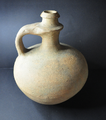TI·10
| Inscription | |
|---|---|
| Reading in transliteration: | ueṇu |
| Reading in original script: | |
|
| |
| Object: | TI·10 Giubiasco (pitcher) |
| Position: | shoulder, outside |
| Orientation: | 0° |
| Direction of writing: | dextroverse |
| Script: | North Italic script (Lepontic alphabet) |
| adapted to: | Latin script |
| Letter height: | 0.8–1 cm0.315 in <br />0.394 in <br /> |
| Number of letters: | 4 |
| Number of words: | 1 |
| Number of lines: | 1 |
| Workmanship: | scratched after firing |
| Condition: | complete |
|
| |
| Archaeological culture: | Augustan [from object] |
| Date of inscription: | late 1st c. BC [from object] |
|
| |
| Type: | unknown |
| Language: | Celtic |
| Meaning: | 'Uenu' |
|
| |
| Alternative sigla: | Whatmough 1933 (PID): 260 Tibiletti Bruno 1981: 3 Solinas 1995: 8 Motta 2000: 23 Morandi 2004: 11 |
|
| |
| Sources: | Morandi 2004: 524–526 no. 11 |
Images
Commentary
First published in PID: 77, no. 260. Examined for LexLep on 20th July 2021.
Images in Ulrich 1914 II: Taf. LXXXVIa.10 (photo), Solinas 1995: tav. LXId (photo), Motta 2000: 213, fig. 20 (photo), Pernet et al. 2006: 233, fig. 6.39 = pl. sub 385.3 (drawing).
Inscribed on the shoulder of the olpe, deeply incised and well legible (length 2.3 cm). Initial upsilon and epsilon are unambiguous. The third letter is unusual, but generally identified as a form of nu, Whatmough observing that heta is not used in the Lepontic alphabet; Whatmough's reading is accepted by Pisani 1953 = Pisani 1964: no. 120 H; Lejeune 1971: 62; Tibiletti Bruno 1978: 143 ("con grafia latineggiante"); Tibiletti Bruno 1981: 158, no. 3 ("n retrogrado"); Solinas 1995: 324, no. 8 (with the n marked by a dot); Motta 2000: 213, no. 23; Morandi 2004; Pernet et al. 2006: 229 (tab. 6.2). If the letter is indeed Latin nu, it must be miscarved, as the form is not otherwise attested in Latinised Lepontic inscriptions. The corner between hasta and bar on the left is chipped off, but Latinoid mu ![]() (not san, see TI·5) with one prolonged bar is even less plausible. Whatmough's reading uenu lends itself to linguistic analysis in terms of both the base and the ending (personal name in the nominative; see the word page). The last letter form
(not san, see TI·5) with one prolonged bar is even less plausible. Whatmough's reading uenu lends itself to linguistic analysis in terms of both the base and the ending (personal name in the nominative; see the word page). The last letter form ![]() is reasonably well attested in the corpus as upsilon, though the co-occurrence with regular
is reasonably well attested in the corpus as upsilon, though the co-occurrence with regular ![]() is strange – possibly another imperfectly carved letter.
is strange – possibly another imperfectly carved letter.




